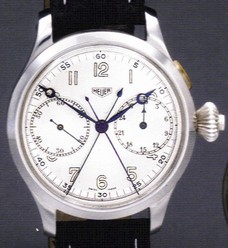I would suspect that the "expertise" embedded in the examination and description of any item is directly proportional to the expected value of that item. I'm sure that their top Patek and Rolex guys do a good job with those high-dollar lots. Where it seems to fall off, however, is with the lower priced brands, of which there are very few lots in the sale. I suspect that there is good information concerning the $100K Pateks; there is no real knowledge or information about the $3K Heuers.
It seems that the low-priced stuff is just "filler" in these auctions, to give people something to watch or even play with, between the more important pieces. It's really not a good market, to buy or sell our beloved Heuers and other similarly-situated "tool watches".
I remember a Christie's auction several years ago, where one of the five Heuer lots was an oversized fake (make in the Czech Republic, and shown below). Days before the auction, I spoke to one of the Christie's guys about the piece, and told him the whole story. He seemed to show great concern, and marked it as "Provenance Uncertain" [kind of ironic, because I knew of the guy in the Czech Republic who had made it, from a stopwatch, within the past year]. The piece sold for around $5,000, to someone who thought that it "looked like fun", even if it was a recent fabrication. I suppose that's the power / profitability of Antiquorum or Christies -- having people in the room who can toss around $5,000, for a fake watch, that looks like fun. At the time, these were selling for around $3,500 on ebay, with the sellers having an elaborate -- but fraudulent -- story about their authenticity.
Jeff


